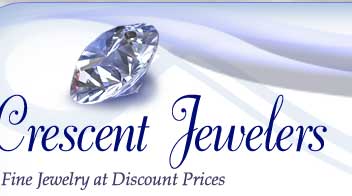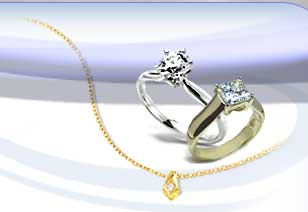| Diamond
Guides
Carat Weight
You may think that diamond weight is the easiest of the 4 C's to
determine (carat weight, clarity, color, and cut). The answer is,
not always.A diamond that weighs less than one carat may look larger
than one that weighs more than one carat. That’s because in
some cases the weight may be concentrated in the depth. A diamond
that is shallow will look bigger but will handle light differently
that a deeper diamond. Download
our printable PDF file to bring with you when shopping for diamonds.
Clarity
Most diamonds
have inclusions trapped inside them known as crystals, clouds, and
feathers. These markings are the characteristics that were captured
in the diamond when the crystal was growing. They tell the story
of the diamond’s natural formation. Clarity grades are a way
to rank their influence on beauty, durability and rarity. What determines
the Clarity grade given? A diamond is graded based on the overall
visibility of the inclusions under 10 power magnification. Size,
number, position and type of inclusions determine the final grade.
Download our printable
PDF file to bring with you when shopping for diamonds.
Color
Color differences
may not be obvious. Think of the many different whites available
at a paint site. Diamonds are judged and graded in controlled lighting
conditions and compared to a master set for accuracy. The diamond
is then assigned a letter grade from a color scale established by
The Gemological Institute of America (GIA).D color grade stands
for the absolute absence of a body tint. The further down the alphabet,
the more body color the stone has. However, it is extremely difficult
to detect any difference between D, E, and F. Grades that range
between G and H will also appear colorless except when placed right
next to D. Not everybody's eyes are the same, but as a general guide
most people will start to notice a very slight yellow tint in grades
J, K, L, especially in larger stones.
Download our printable
PDF file to bring with you when shopping for diamonds.
Cut
Cut is different
than shape. Cut refers to how a diamond is proportioned. Shape refers
to the outline of the diameter. Some popular shapes are round, oval,
square, pear, rectangular, trillion, and heart shaped. Each of these
shapes can be cut in different styles of faceting. Differences in
Cut are easy to see but not so to define . A diamond that is well
cut will seem to inhale light and breathe fire. A diamond that is
deficient in cut will be obvious next to such a dazzler.Get the
numbers but trust your eyes. Consider the cut with as much emphasis
as you would the carat weight, clarity, and color.
Download our printable
PDF file to bring with you when shopping for diamonds.
Diamond
Appraisal
There are a variety of Gemological Institutes that
appraise diamonds and issue Diamond Gemological Reports, measure
and certify loose diamonds and diamond jewelry. Crescent Jewelers
follows the guidelines of the following organizations:
 |
GIA - Gemological
Institute of America. Founded in 1931 in Los Angeles, the GIA
created and introduced the international grading system. Headquarters
are still located in Los Angeles. |
 |
GemScan - GemScan International
was incorporated in 1985 as an independent jewellery appraisal
laboratory providing gem identification. Gemscan is based in
Toronto, Ontario Canada |
 |
AGS - American Gem Society
Founded in 1934 by Robert M. Shipley who also founded the GIA.
The AGS is based in Nevada, USA. |
|





